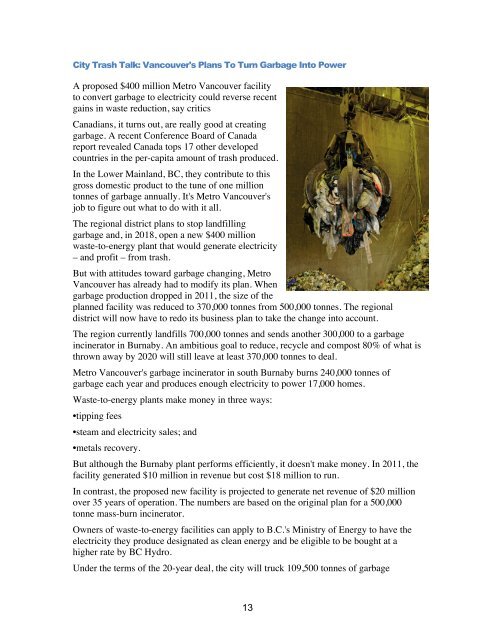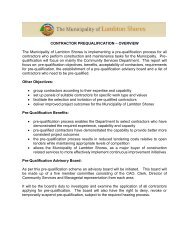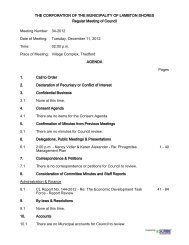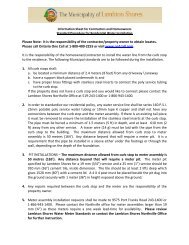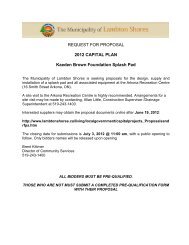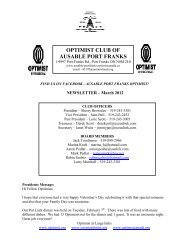View - The Municipality of Lambton Shores
View - The Municipality of Lambton Shores
View - The Municipality of Lambton Shores
Create successful ePaper yourself
Turn your PDF publications into a flip-book with our unique Google optimized e-Paper software.
City Trash Talk: Vancouver's Plans To Turn Garbage Into Power<br />
A proposed $400 million Metro Vancouver facility<br />
to convert garbage to electricity could reverse recent<br />
gains in waste reduction, say critics<br />
Canadians, it turns out, are really good at creating<br />
garbage. A recent Conference Board <strong>of</strong> Canada<br />
report revealed Canada tops 17 other developed<br />
countries in the per-capita amount <strong>of</strong> trash produced.<br />
In the Lower Mainland, BC, they contribute to this<br />
gross domestic product to the tune <strong>of</strong> one million<br />
tonnes <strong>of</strong> garbage annually. It's Metro Vancouver's<br />
job to figure out what to do with it all.<br />
<strong>The</strong> regional district plans to stop landfilling<br />
garbage and, in 2018, open a new $400 million<br />
waste-to-energy plant that would generate electricity<br />
– and pr<strong>of</strong>it – from trash.<br />
But with attitudes toward garbage changing, Metro<br />
Vancouver has already had to modify its plan. When<br />
garbage production dropped in 2011, the size <strong>of</strong> the<br />
planned facility was reduced to 370,000 tonnes from 500,000 tonnes. <strong>The</strong> regional<br />
district will now have to redo its business plan to take the change into account.<br />
<strong>The</strong> region currently landfills 700,000 tonnes and sends another 300,000 to a garbage<br />
incinerator in Burnaby. An ambitious goal to reduce, recycle and compost 80% <strong>of</strong> what is<br />
thrown away by 2020 will still leave at least 370,000 tonnes to deal.<br />
Metro Vancouver's garbage incinerator in south Burnaby burns 240,000 tonnes <strong>of</strong><br />
garbage each year and produces enough electricity to power 17,000 homes.<br />
Waste-to-energy plants make money in three ways:<br />
•tipping fees<br />
•steam and electricity sales; and<br />
•metals recovery.<br />
But although the Burnaby plant performs efficiently, it doesn't make money. In 2011, the<br />
facility generated $10 million in revenue but cost $18 million to run.<br />
In contrast, the proposed new facility is projected to generate net revenue <strong>of</strong> $20 million<br />
over 35 years <strong>of</strong> operation. <strong>The</strong> numbers are based on the original plan for a 500,000<br />
tonne mass-burn incinerator.<br />
Owners <strong>of</strong> waste-to-energy facilities can apply to B.C.'s Ministry <strong>of</strong> Energy to have the<br />
electricity they produce designated as clean energy and be eligible to be bought at a<br />
higher rate by BC Hydro.<br />
Under the terms <strong>of</strong> the 20-year deal, the city will truck 109,500 tonnes <strong>of</strong> garbage<br />
13


